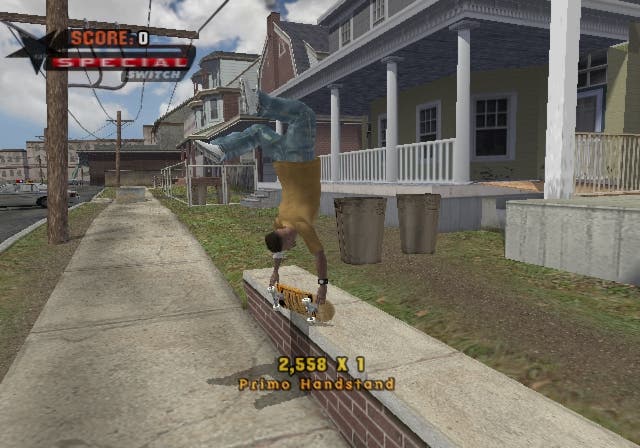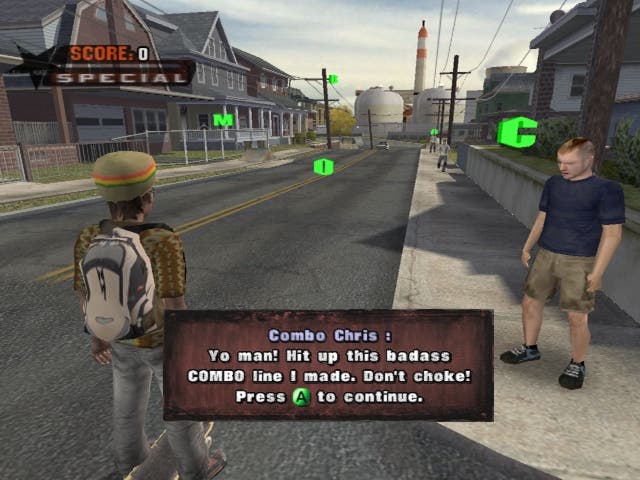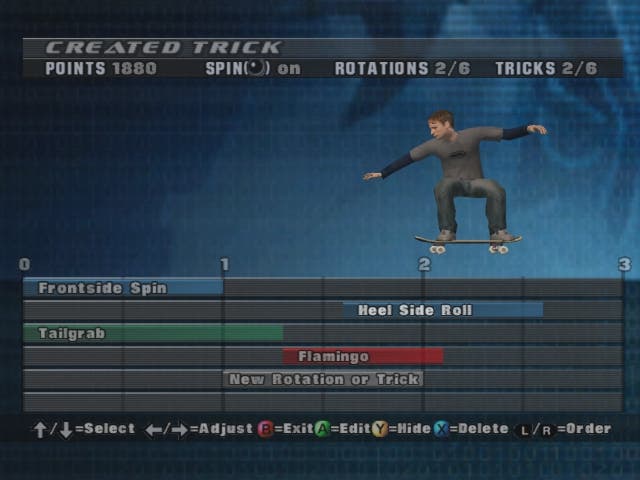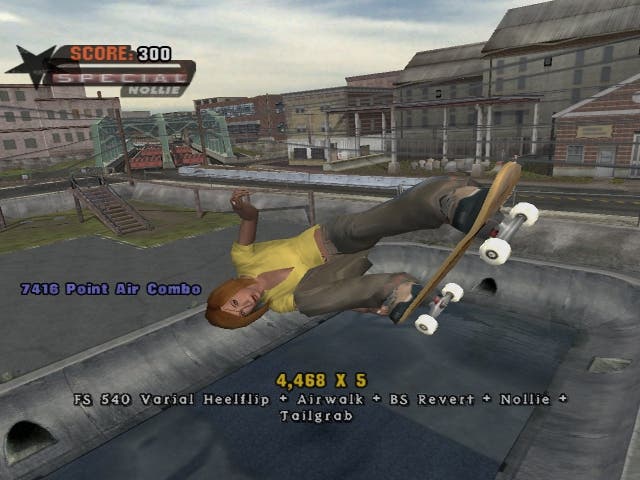Tony Hawk's Underground
Tony's back, and this time he's you!
Although Activision will tell you that Tony Hawk's Underground (or THUG) is more than just the fifth Tony Hawk title in as many years, these days Neversoft's extreme sports skating franchise operates on much the same terms as any other sports game - you get a new version every 12 months and it'll probably have enough gimmicks and marketing devices on top of last year's feature list to hook you in. THUG is no different, offering more customisation options, more game modes, more online options and more tricks whilst relying on the same core technology and gameplay and arguably moving further sideways than it does forwards. Then again, that's kind of how skateboards work...
(Why) Haven't you grown!

Of course, Activision isn't lying exactly - THUG is a different game to its predecessor - but the thing is that most of the changes are very superficial. There's a new story mode, focusing on a hackneyed narrative strand in which the player's nameless character has to evade local drug dealers, find the best rail lines, meet pro skaters, and finance a skate demo video to impress a local shop owner into sponsoring him amongst other things (All the more comic when you combine it with the expansive range of character customisation options, and your skull-on-a-suited-body of a character still stands there delivering heartfelt dialogue), but for all its efforts it still sits on top of the roaming dynamic of THPS4 - with the player picking up missions from various non-player characters dotted around each level and, gasp, not having to complete them in any particular order! (And sometimes not at all.)
Then there's the option to get off your skateboard, climb buildings and even drive the odd car, but these feel aspects like they've been attached with an old stick of glue that's about as adhesive as baby oil. Climbing off your board is a simple matter of pressing L1 and R1 together, and on the one hand this is helpful in allowing you to climb buildings looking for places to start impressive combos from, and in allowing you to jump off the board mid-combo and then run a little way to continue it on another rail (with a little clock ticking down gently or furiously depending on how far you've got into a combo), but on the other hand the jumping (X) and ledge-grabbing/climbing (R1) looks painfully out of place, and feels very clunky and awkward (An early "stealth" mission to retrieve deck parts from drug dealers by jumping between awnings is just rubbish as a result).
As for the driving - this is hardly Grand Theft Auto, despite what you may have read. You aren't running around a giant city driving between the best skate spots and so on; you just occasionally get to drive a car within the confines of the strictly linear single-player Story mode and its range of THPS4-sized levels. Disappointing? Well, when you actually get into a car, it's hardly surprising - the handling, physics, controls, look, feel and even sound effects are incredibly poor, and these are without question the weakest and most alien elements of the game.
Who's scruffy-lookin'?

However Neversoft has always been a bit odd like that. As a developer, they're incredibly good at building up balanced and enjoyable gameplay (see also Spider-Man on the PSX), but they seem to be a bit crap at fleshing out games with interesting ideas and they seem almost allergic to polish (ditto).
THUG feels as messy and rough around the edges as ever before. Graphically it's a bit less quirky at times, and in technical terms it checks every box except 60Hz with 4:3, letterbox, widescreen and Dolby Pro-Logic II options (and DD 5.1 on the Xbox), but it's still hilariously rough, with peculiarly unkempt collision detection for the fifth game to use this technology, sharp, angular character models, eerily unrealistic lighting and odd little moments when the player is trying to turn round and ends up banging into a curb, flinching, banging, flinching, banging, flinching and so on until he gives up and either jumps off the board, stops completely or goes the other way - a persistent pain in the neck, if you ask me. It also seems amazing to me that the juddering inelegance of the "Task Complete!" pop-up ever escaped quality assurance.
Arguably, though, the rugged, unsanded look and feel of THUG is something that doesn't particularly matter now that the gameplay has truly established itself, but I have to wonder how much more accessible and enjoyable a game THUG would be if Neversoft had taken a year off and built up a spangly smooth graphics engine to rival the SSXes and Ampeds of this world. Instead though we just have more of the same - with new animations for being thrown off the board and some new tricks, but an otherwise unchanged and increasingly antiquated look and feel.
Neversoft or Neverhard, it's your choice

The other element of THUG that Activision has been promoting heavily is that it's your adventure, it's your completely customised character and it can even be you. All you have to do to get your face on a skater is email a digital picture of yourself to THUGonline.com and before long you have a face you can slap on a character model and manipulate to your heart's content. It's a nice gimmick (although obviously the result is more of a caricature than anything else), but the Create-A-Skater mode represents a lot of fun even if you don't have a digital camera. We see a lot of these Create-A-Whatever modes around here and THUG's is one of the most complete to date, allowing you to tackle just about anything - hairstyle, shoes, hats, facial hair, skin texture, colour, contrast, skateboard design and even tricks, of which more later.
To recap the story so far, then, THUG is about as revolutionary as a Michael Bay movie. The marketing would have it one way, telling you about this massive, sprawling world in which you are the budding star, right down to the crook in your nose and that mole on your cheek, and a more mature, rugged Hawk that breaks down boundaries enforced by previous versions. But anybody who actually gets their hands on THUG is going to be left thinking, "Well, it's more of the same, isn't it?" There are bells and whistles, but they're not exactly the gongs and foghorns of their respective hierarchies...
However, none of the above means that Tony Hawk's Underground is a bad game - far from it, it's actually one of the best games in the series. One thing it benefits from particularly is the newfound difficulty levels - their introduction is a massive boon to newcomers and veterans alike, meaning that you're almost certainly going to find a forgiving or challenging enough game depending on what you want. As a "pick-up-and-play" sort of game, THUG is endlessly rewarding once you get your head round the basics, and it's the best entry point for the series to date.
Same game, different name

Fundamentally the game remains as playable as ever before, and feels the same to play - with masses of tricks to learn, insane rail routes that help you piece them together, level design that has you zooming in every direction without ever really losing your footing on the board, and plenty of itemised goal lists that will still have you scrambling to perform every last feat, whether it's the time-honoured pantomime of collecting SKATE letters, performing a particular grind move round the edge of a harbour or holding a position for a few seconds to level up a particular skill set. The controls and the way you play the game haven't changed - you still jump (X), grind (triangle), kickflip (square) and grab (circle) with all manner of variations on the above, and various special tricks to use when you've filled up your special meter, and you still tend to hurtle around rail routes like you're on a rollercoaster, often ignoring your apparent goals just so you can let loose for a while. A very passive pursuit - ideal to unwind with.
Ironically though, given the generally held view of skaters as nuisance layabouts, it can also be a remarkably active and creative outlet, with a skatepark builder that goes even further than the previous ones, allowing you to add various goals (SKATE collection, races, platform sections, etc) to your custom parks (with a refined editing tool that lets you plot rail routes like lines in a graphics program), and a Create-A-Trick mode that lets you layer different aspects of a trick (the rolls, flips, turns, grabs, etc) onto a timeline and then bind them to a button combination. You can get about 20 of them on a single 8MB memory card, but if you really think this is going to take over your life then you might want to consider the expansive hard disk alternative of the Xbox.
Is there anybody out there?

Sadly though by opting for the Xbox (or Cube) version, you'll be missing out for the third time on Tony Hawk's online elements. Does it really matter? Given the amount of creative outlets, the wealth of moves to unlock and learn and the masses of content to plough through, you could happily live without the online element, but it's definitely a plus for the PS2 version, and unlike most PS2 Online games, people actually play it! Up to eight players can tinker with various modes that don't differ hugely to those of THPS4 (which we covered here), with Trick Attack, King of the Hill, Horse, CTF and of course Graffiti returning happily, joined by some new modes like Firefight in which, er, everybody spits fireballs (and camps spawn points), and there's also a sort of drop box for custom skaters, tricks, skateparks and other gimmicks, which you can either help to fill or scour for new toys.
All in all then, it's another solid and thoroughly detailed Tony Hawk game. There's so much to do that initially it gave me the reviewer's equivalent of stage fright, and despite its greying looks, typically brash Hawkish presentation (including the vast, requisite soundtrack of indie, punk, rock skater songs featuring everybody from The Clash to Jane's Addiction) and marketing-driven structural changes, it retains the same key formula that made the first game so important and enjoyable. If you haven't played a Tony Hawk game yet, or haven't looked in since the days of "two minutes, many goals, no stabilisers", then you'll probably enjoy this as much as any genuinely triple-A title released this Christmas.
Going Pro
Then again, while Neversoft deserves credit for serving up another solid extreme sports game on such short notice - and one where strength of level and trick design shine brighter than a creaky engine, rough edges and recycled ideas - this is the fifth game in a series that is crying out for a genuine rethink, lest it tumbles into the routine that sent FIFA off the rails at the height of its popularity. When your fifth game is still ostensibly the same as the first one, visually and mechanically, even fans are going to have trouble justifying the outlay in a sea of brilliant festive releases. (Or rather, everyone's already been brainwashed into buying this one, but next time it'll take more than Grand Theft and a digital camera to keep us interested. Hopefully.)
Not the best game released for Christmas 2003 then, not the best extreme sports title released in November either, but probably the best Tony Hawk game to date. Curiously it's also the lowest scoring. Why? Partly because the marginal improvement on display here is happily eclipsed by rival extreme sports titles which do take steps to reinvent themselves, and partly because there are four other Tony Hawk games out there and they all do much the same thing. Still, if you're just after more of the same, then this is definitely the ticket.

